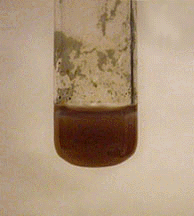Characteristic Reactions of Cobalt Ions (Co²⁺)
- Page ID
- 97268
- Most common oxidation states: +2, +3
- M.P. 1495º
- B.P. 2870º
- Density 8.92 g/cm3
- Characteristics: Cobalt is a steel-gray, hard, tough metal. Dissolves easily in \(\ce{HNO3}\) and also in dilute \(\ce{HCl}\) and \(\ce{H2SO4}\).
Characteristic reactions of Co²⁺
Aqueous Ammonia
Excess concentrated ammonia reacts with cobalt(II) ion to form a metal complex ion, hexaamminecobalt(II) ion:
\[\ce{Co^{2+}(aq) + 6NH3(aq) <=> [Co(NH3)6]^{2+}} \nonumber \]

If an insufficient amount of ammonia is present, the reaction results instead in a precipitate of a basic salt, \(\ce{Co(OH)NO3}\) (blue) or \(\ce{Co(OH)2}\) (rose-red), which can co-precipitate with other metal ions that form hydroxide precipitates, causing complications when trying to separate metal ions:
\[\ce{Co^{2+}(aq) + OH^{-}(aq) + NO3^{-}(aq) <=> Co(OH)NO3(s) } \nonumber \]
Sodium Hydroxide
Sodium hydroxide first precipitates the basic salt just described. This basic salt is insoluble in excess sodium hydroxide, but is soluble in acids. When heated, the basic salt hydrolyzes to form \(\ce{Co(OH)2}\). Cobalt(II) hydroxide is slowly oxidized by atmospheric oxygen to form brown \(\ce{Co(OH)3}\).

Ammonium Thiocyanate
Addition of a concentrated solution of ammonium thiocyanate to solutions containing cobalt(II) ion results in a blue color, due to formation of a complex ion, tetraisothiocyanatocobaltate(II) ion:
\[\ce{Co^{2+}(aq) + 4NCS^{-}(aq) <=> [Co(NCS)4]^{2-}(aq)} \nonumber \]

This complex ion is more stable in the presence of acetone; the blue color can be enhanced by addition of about an equal volume of acetone.
No Reaction
\(\ce{Cl^{-}}\), \(\ce{SO4^{2-}}\)


